

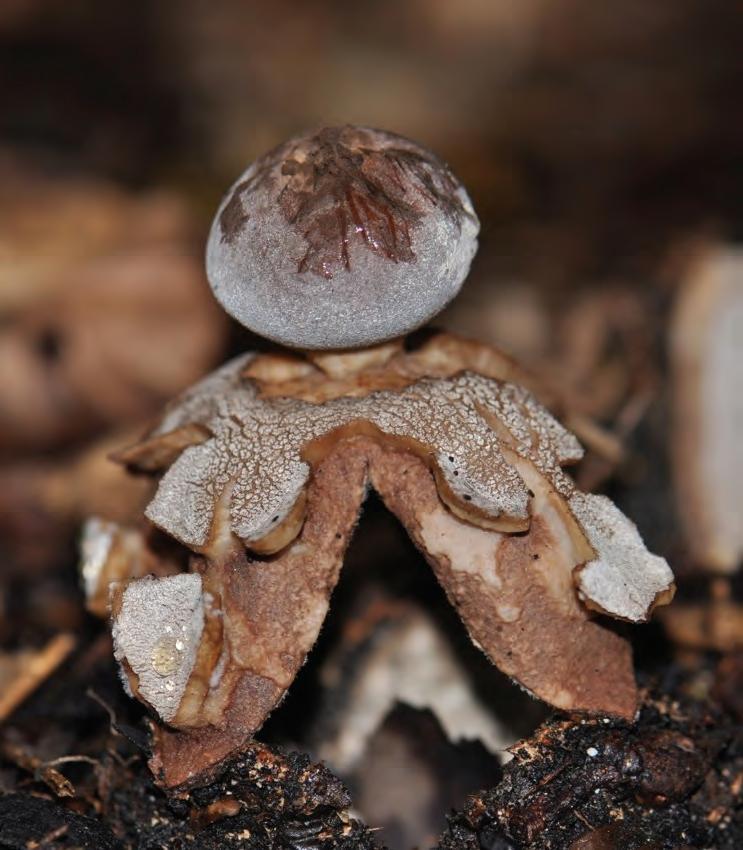
EDITORIAL SNIPPETS AN EARLY AUTUMN DAY ON THE DEBEN RARE AND NOT-SO-COMMON FUNGI FOUND IN SUFFOLK




EDITORIAL SNIPPETS AN EARLY AUTUMN DAY ON THE DEBEN RARE AND NOT-SO-COMMON FUNGI FOUND IN SUFFOLK

Lower Street, Stutton
Suffolk IP9 2SQ
Quercus121@aol.com
The Suffolk Naturalists’ Society is in grave danger of closing down. Council met on 9th November and, to enable business to carry on until the next AGM, made temporary appointments from within its existing membership to fill the roles of Chairman and Treasurer that had been unexpectedly rendered vacant. (Details are given on p.36).
Membership numbers are falling. The field programme was suspended, for at least one year, in 2008. Few meetings are arranged; when they are, attendance is low. There is little or no communication to or from members. Subsidiary groups have gone their own way. Is it just the publications (Transactions, Bird Report and newsletter) that members want in return for their annual subscription?
No single person is responsible for the state the SNS is now in: it is simply following the same trend as most other natural history societies.
There are two basic requirements for starting to put things right:
1. In some way or other the membership must let Council know what they want from the society. Not doing so means Council has to work in the dark.
2. New ‘blood’ must join Council. Ideally, younger people will come forward who have the drive and enthusiasm to take on the challenge of revitalising the society and making it work. What we need is new ideas, organisational skills, energy and dynamism.
If 1 and 2 are fulfilled, new activities reflecting the interests and matching the wishes of the membership can be identified and put into operation. If they are not, it is likely that the society will have to disperse its funds to other charities and quietly die.
I am not overstating the case, please take this seriously. Come to meetings, especially the AGM. Correspond with us, say what you want. It is your society!
A brighter note to end on: the Editor’s November Award for Stoicism goes to the Collared Dove that has just raised a sixth pair of chicks in the rainwater gutter here at Ancient House. Five months ago she was enduring daily exposure to baking hot sunshine, quite a contrast with recent conditions - downpours of biblical volume resulting in two-and-a-half inch deep, and fast, torrents of storm water. I hope the newest clutch will be able to gain sufficient fat reserves to survive the winter. See photo on p. 18.
WA sends congratulations to poet naturalist Alasdair Aston whose book ‘Suffolk Boy’ was shortlisted for the first-ever New Angle Prize for Literature. Alasdair, whose family moved to Stowmarket from Hunstanton when he was eight years old, has found inspiration for many of his poems in memories of childhood life in rural Suffolk. He joined the Suffolk Naturalists’ Society in 1942 at the age of eleven. His poems have won Cambridge University’s prestigious Seatonian Prize eight times.

The New Angle Prize, given by the Ipswich Institute, is a biennial competition open to ‘recently published books of literary merit, associated with or influenced by East Anglia’. The winner was ‘Crow Country’ by Mark Cocker.
This summer saw Suffolk’s first confirmed recordings of two Emerald Damselflies: the Scarce Emerald Damselfly Lestes dryas and - highlight of the year - the Willow Emerald Damselfly Lestes (Chalcolestes) viridis. Two Scarce Emerald Damselflies were recorded at Redgrave Fen by Andrew Godfrey in late June. The Willow Emerald, a migrant vagrant, was recorded at two sites at the start of August. Will Brame, Eddy Marsh and Justin Zantboer recorded a singleton at Trimley Marshes on the 1st August and Steve Goddard recorded several on the 2nd at Staverton Lake. Informed opinion says that these sightings could well result from an established breeding population in the Orwell area.
The Suffolk Naturalists’ Society is a registered charity, number 206084. Details of information supplied to the Commission by the Society can be viewed on the website: www.charity-commission.gov.uk/.
A new soil strategy for England has been published by Defra. Safeguarding our Soils can be seen at www.defra.gov.uk/environment/quality/land/soil/documents/ soil-strategy.pdf.
The news media recently gave a lot of attention to the joint report of the World Wildlife Fund and the Food Ethics Council that addressed the issue of livestock products in relation to climate change. The report can be downloaded from:- http://www.wwf.org.uk/ research_centre/?3308/Livestock-consumption-and-climatechange---A-framework-for-dialogue. (phew!)
A study by the BTO has come up with the unsurprising finding that organic farms are better for farmland birds (six species out of 16 did better on organic farms). Total numbers of birds were also higher on organic farms.
A study by German biologists published in the Biological Journal of the Linnean Society (2009, 97) suggests that shrews use faint, high-pitched laryngeal calls for echolocation purposes. Researchers found that Common Shrews and Greater Whitetoothed Shrews use echoes and reverberations of their calls for investigating their habitat or for identifying routes through it.
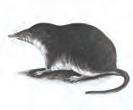
Wednesday 23rd September 2009 was a bright and sunny day and I decided to spend it exploring the River Deben. Standing on a humpbacked bridge north-west of Wickham Market I looked down at the water, as I always do when arriving at a site, searching for surface dwelling invertebrates before climbing down the bank with my net. However, my eye was immediately taken by several large patches of silver sparkling water, which I could see through my binoculars were whirligig beetles. The number of patches varied because as I watched they would join together or drift apart seemingly at random but, I estimated that together the whirligigs covered around 20 square metres. The space between the individual beetles was only a few centimetres and even a conservative estimate of one beetle per 25 square centimetres would mean that the river was covered in several thousand beetles.
This is by no means an unusual event at this time of the year, as these ‘schools’ or ‘flotillas’of whirligigs often occur in late summer. In the Autumn edition of White Admiral (65), I reported a similar occurrence at Lound Lakes.
The flotilla seen at Lound was formed of the species Gyrinus marinus and I wondered if the same species was occurring below me on the Deben. I always carry a plankton net with me as well as a frame net with a handle. The plankton net is cone-shaped and designed to be pulled through the water on a rope. I dropped the plankton net from the bridge onto the nearest of the patches of beetles and found when I hauled it up onto the bridge that I had caught 41 beetles. This sample was composed as shown in Table 1.
These late summer / early autumn ‘schools’ or gatherings of whirligigs are often a result of the second brood of the year having hatched recently, as happens generally in the autumn. The autumn brood is the one that hibernates. The obvious hypothesis here is that grouping in such large aggregations may well increase breeding success for individual beetles. However, the hibernating second brood will not breed until the Spring. Experimental work in the USA by Romey and Rossman suggests that larger groups of whirligig beetles detect approaching predators sooner than smaller groups because there is a greater probability that at least one beetle in the group will see the predator (“the many eyes hypothesis”). The rapid whirling of startled
whirligig groups is also thought to function in confusing predators and in advertising the defensive chemicals which they secrete when stressed. Higher temperatures and more abundant food supplies are also thought to increase the likelihood of larger schools of whirligigs.
The large ratio of males to females, which is greater than two to one is a puzzling fact if mating is not a reason for the school to form. The fact that two other species had joined the school possibly supports the ‘safety in numbers’ hypothesis, except that no females of these species were taken. The sample taken from the group should be a random one with the net dropped from a height of about five metres onto the centre of the school. There is of course a possibility that females were able to swim away from the dropping net more successfully than males.
The record was a very useful one for the county dataset as both Gyrinus aeratus and G. urinator are nationally notable species. G. substriatus is commonly recorded throughout Suffolk and in fact is as common nationally as all other species put together. Although there are regular occurances of G. urinator it is certainly not a common whirligig. Gyrinus aeratus on the other hand has far fewer records from Suffolk.
Gyrinus aeratus The Bronze Whirligig
2009 first record in 62 years
Gyrinus paykulli The Long Whirligig No records
Gyrinus caspius The Caspian Whirligig common
Gyrinus distinctus The Distinguished Whirligig No records
Gyrinus marinus The Mariner Whirligig one record
Gyrinus minutus The Little Whirligig No records
Gyrinus natator The Shady Whirligig Extinct in Britain
Gyrinus opacus The Highland Whirligig not recorded (confined to Scotland)
Gyrinus substriatus The Common Whirligig Very common
Gyrinus suffriani Suffrian’s Whirligig No records
Gyrinus urinator The Artist Whirligig Occasional records
Orectochilus villosus The Hairy or Nocturnal Whirligig Occasional records
The last record I can find was from Dedham Mill pond in 1957. Earlier records sent to me by Garth Foster of the Balfour Browne Club were one from Mildenhall in 1947, another from Dunwich in 1926 and before that from Brandon in 1925. Finding such a large population of this beetle in central Suffolk hopefully means that it may be recorded more widely in future.
References
Romey, W. L. & Rossman, D. S. (1995). Temperature and Hunger Alter Grouping Trade-Offs in Whirligig Beetles . American Midland Naturalist 134 (1): pp. 5162.
Foster, G. (2008). Whirligigs in Britain and Ireland. British Wildlife. 20 (1): pp. 28 - 35.
Adrian Chalkley County Recorder for Freshwater Invertebrates
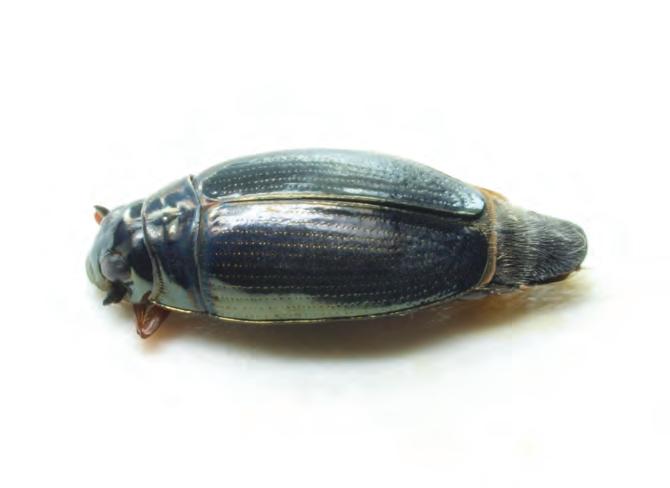
Fig. 1 Preserved specimen of Gyrinus aeratus. Total length from front of head to tip of elytra = 5mm. (Preservation in alcohol causes the abdomen to swell beyond the ends of the wing cases).






Polyporus umbellatus
New to Suffolk, found by Neil Mahler in Captain’s Wood
Grifola fondosa
The closest look-alike of Polyporus umbellatus. Appears on the base of Oak trees. Not common
Geastrum fornicatum
An earthstar known at only six sites in Suffolk. These were at Redgrave & Lopham Fen on October 3rd.
Close-up on front cover
This year has seen a spectacular crop of Knopper galls on my oak trees, so numerous that it was almost impossible to find a normal acorn. As the acorns started to develop during July it became clear that something was amiss. Little green frills appeared around the edges of the acorn cup and quickly grew into the strange misshapen gall caused by a small gall wasp (Andricus quercuscalicis). There was generally one per acorn but sometimes two or three grew in the same acorn cup. The galls were green or bronze in colour and were covered in a sticky resinous substance; this dried up as they matured and became a fawn/orange colour.
Galls plucked from the tree every three or four days were cut through to follow the development of the wasp. The larva was at first embedded in green tissue at the base of the gall; as it grew the tissue around it thickened, eventually making a thick walled spherical capsule. The galls started to fall from the tree during September and had become so hard and woody that a kitchen knife and mallet were needed to cut them in half. The tissue had dried and pulled away from the capsule which lay free in the cavity. Breaking open the capsule exposed a white pupa, or more frequently the imago wasp, fully pigmented.
To estimate the number of galls on the tree, the canopy was treated as a hemisphere. Measurements of the radius of the crown and the number of galls per square metre yielded an estimate of 91,000 galls. This involved a number of assumptions, for example, that the galls are evenly distributed all over the canopy, justified as far as possible with binoculars. Even if this number is out by 100%, 40,000 galls per tree is a very large number. Many trees in Westleton parish are equally severely infected, suggesting astronomical numbers of knopper galls in the area. The gall is produced by the agamic generation of the wasp, the alternate, sexual generation of which is produced in bud galls on Turkey oak (Quercus cerris). The nearest Turkey oak trees that have been located so far are in Dunwich Forest, about 2 km away. The mind boggles at the thought of hordes of the tiny wasp migrating across the open fields in the spring.
The life cycle of the Knopper gall wasp is similar to that of the marble gall which also occurs on Quercus robur and the alternate host of which is also the Turkey oak. In some cases, where marble galls occurred there were no Turkey oaks in the vicinity and it was suggested that the life cycle had adapted so that the sexual generation was omitted and the parthenogenetic females emerging from the marble gall were able to lay their eggs on the buds of Q. robur (Redfern & Askew, 1998). Such a change in the Knopper gall wasp life cycle might explain the very high incidence of Knopper galls in trees remote from turkey oaks, but direct evidence for such a change is lacking.
Depending on one’s point of view, the Knopper gall wasp is either a threat to our oak trees or a fascinating creature worth more study.
Reference
Redfern, M. & Askew, R. (1998). Plant Galls. Richmond Publishing, Slough.
Michael KirbyThe Suffolk Moth group arranged a visit to Dunwich Forest on the night of the 31st July 2009. This was one of several planned recording sessions at the site during the year, with the principal aim of carrying out survey work of the forest prior to changes in management. The target for this night was to try and cover the part of the forest that met with the reed-beds to the south of Walberswick, looking for the White-Mantled Wainscot Archanara neurica.
Five recorders were present: Matthew Deans, Keith Knights and Neil Sherman from Suffolk as well as John Chainey and Jenny Spence from Hertfordshire. At the site, the habitats consisted of areas of Scots pine plantation, oak/birch woodland, reedbed and damp fen. Five 125w MV (Mercury vapour) light traps were deployed, as well as a 125w MV bulb placed over a white sheet. Some lights were placed close to the reed-bed edge with the others on a track through the forest. Conditions looked very good, with cloud cover (for the first part of the night) and temperatures in the high teens.
Moths soon started to come in to the sheet light, keeping the group busy recording the species. It was decided to check the traps after about one hour to see what had been trapped.
On the first trap round, a small carpet-type moth was boxed up by Jenny at one of their lights and passed to John to identify. When the group met up, the moth was shown around, most of us realizing what it was but not believing what we were seeing. We identified it as Devon Carpet Lampropteryx otregiata, a moth that was completely unexpected. The specimen was quite badly damaged, with one forewing virtually missing. This prompted the discussion as to where it could have come from. John and Jenny had trapped a few days previously in the New Forest, Hampshire and the Portland area of Dorset, both areas where the moth occurs. They could not recall actually capturing the moth at either site, but there was always the possibility that it could have been missed and imported in with their moth traps. After some discussion, this was thought to be improbable as the equipment had been stored in a car for a few days and the weather had been warm so any moths left by accident in the traps would surely have died. Due to the uncertainty of where the moth had come from it was decided not to claim the moth as a new species to the county at that point. Fortune was with the group however, as another specimen was captured shortly afterwards in one of the traps placed on the edge of the reedbed, this time in much better condition, confirming the initial identification. This trap was surrounded by Marsh Bedstraw, the food-plant of the moth, and there were also good stands of the plant in close proximity. No more Devon Carpet appeared at light that night, which was not that unexpected as John had informed us that the moth generally flies at dusk and just afterwards. Both specimens of the moth were retained, the first one by John and the second by Neil Sherman. The better specimen was photographed the next day and shown to the Suffolk County Recorder, Tony Prichard, who also confirmed our identification.
We also recorded three examples of the target moth for the night, the WhiteMantled Wainscot, these being somewhat overshadowed by the Devon Carpet captures.
At the moment the origins of the moths are uncertain. They could have been migrants or wanderers, but conditions around the time of the sightings were not conducive to migration, with the Silver Y Autographa gamma the only known migrant trapped on the same night. Could it be an overlooked resident species? Possibly, but the Walberswick reedbeds have been well recorded in the past and in modern times and there have been no reported sightings of this moth. Another alternative is that it could be a recent colonist. Discussions with other moth recorders around the UK about the sighting turned up some relevant information on this. Apparently, the moth has been found away from its usual known haunts in the west of Britain at sites in the Midlands in recent years, so the jump to Suffolk is not as far as first thought. This new information is not listed in any of the recent moth book publications. It is quite possible that the moth could be resident in the area, with stands of the food-plant close to the trapping site. More survey work will take place in 2010 to try and prove this.
Neil Sherman (Suffolk Moth Group)
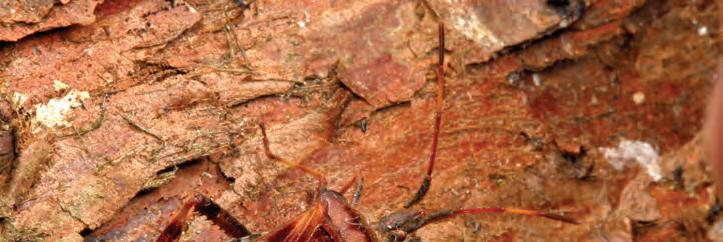
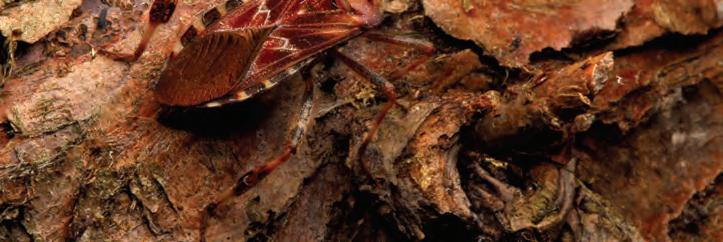
On 2nd September 2009, Mike Wise, warden of Newbourne Springs nature reserve, passed to me a large bug which he was unable to identify from his various books on this group.
Using the internet, I determined it to be Leptoglossus occidentalis, also known as the ‘Western Conifer Seed Bug’. The bug had been collected by Mike’s wife, Sue, from the pavement of Hamilton Road, Felixstowe on 1st September 2009. The bug was passed to Nigel Cuming, Heteroptera Recorder for Suffolk, who informed me that, as far as he was aware, it was the first* record for this County. Interestingly, I have since been told that another individual of this species turned up at the Ipswich Museum under its own steam in the Insect Collection Room!
From information gathered from the Internet, it appears that the bug which, as its name suggests feeds mainly on the seeds and developing cones of conifers, was first described from the west of North America. It has since expanded its distribution across the whole of that continent. The species was introduced into mainland Europe in 1999 and by the autumn of 2008 large numbers of immigrants were reported from the south of England. There were also some scattered records elsewhere. This led to the suspicion that they had arrived with timber imports.
The adult bug hibernates over winter, usually under the bark of trees, but is also known to seek shelter, sometimes in large numbers, within buildings. Presumably
the example found by Sue was looking for somewhere cosy to spend the winter. Felixstowe should offer plenty of choice!
* It turns out that L. occidentalis was recorded in Felixstowe by Justin Zantboer on 22nd October 2008 and was also found in September 2009 at Minsmere and in Colchester.
Ray Ruffell
From the wintry ash
A little owl bewitches
The silent hollows with a mournful dread.
Fine mists are spread
On hedges and on ditches
Bewildering the eye, the hand, the head.
Still, as I walk attentive to disasters, This guardian of quiet and lone acres
Alerts my wits to what it is that masters
The soul on any pilgrimage – the dead.
Only my feet make certain what there is And clay sticks, so softening the fall
As I go home through such a wilderness
Where death swims and emptinesses call.
Alasdair Aston
The Parks Management Board has agreed to parts of Holywells Park in Ipswich being designated a RIGS.
Regionally Important Geological/Geomorphological Sites, designated by locally developed criteria, are important places for geodiversity outside statutorily protected land such as SSSIs. Sites are selected according to their value for:
Education, including lifelong learning
Intrinsic scientific interest
Historical context
Aesthetic value.
A variety of geodiversity features may be seen in Holywells Park. The upper part is on well-drained sand and gravel, exposed in the main path to the Nacton Road gate. Steep slopes have developed on this sandy layer. Below this area, a number of seepages and springs attest to an underlying clay layer impermeable to water. The ground water has been used in a series of descending ponds and at the lowest part of the park a canal further drains the water.



A number of other geological features have been observed over the years. The sand and gravel is in part Pleistocene glacial outwash. Beneath this, Red Crag sand has occasionally yielded fossil molluscs and phosphatic nodules. The underlying ‘London Clay’ mainly belongs to the Harwich Formation and temporary excavations in the canal area have shown green and brown silty sand (part of the ‘Reading Beds’) of the Lambeth Group.
This is a splendid locality for an introduction to contrasting sand and clay areas, to slopes and spring line features and to the use of natural water for park landscaping, with good public access adding to its educational value. The varied geology and associated ground water create an attractive landscape and also support a variety of habitats for flora and fauna in this fine park.
This brings the number of Suffolk RIGS to eight. For more information see www.geosuffolk.co.uk.
Caroline & Bob Markham
When Sutton Knoll (Rockhall Wood Geological SSSI) recently attracted the attention of GeoSuffolk members, it was a largely overgrown, albeit important, mound in the beautiful Suffolk countryside overlooking the River Deben. It had, however, been a site for study for more than 170 years. Five years on, after much hard work and planning, site clearance, and exposures carefully logged, an information panel has been ceremoniously unveiled giving details of a Pliocene Island site both famous and unique and still holding much potential for research.
There were twenty in attendance on May 14th. These included Dr and Mrs Richard Hamblin representing East Midlands Geological Society which had given a donation towards the panel following a field trip in 2007; Dr Jonathan Larwood from Natural England; Neil Lister from Suffolk Coast and Heaths AONB; Professor Richard West of Cambridge, whose research on fossil pollen identified the types of trees growing during the time the Coralline Crag was deposited; Elizabeth Hall of The Lion Associates who produced the panel; and Guy and Jenny Quilter who own Sutton Knoll as part of Sutton Hall Farms and without whom the whole venture would not be possible.
Bob Markham, Chairman of GeoSuffolk spoke first, recounting earlier visitors to Sutton Knoll with original copies of two fascinating publications - The Crag Mollusca by Searles Valentine Wood 1848 and Joseph Prestwich’s paper on his survey of Sutton Knoll from the Quarterly Journal of the Geological Soc. London 1871.
Barry Hall, who has undertaken management of Sutton Knoll and development of the interpretive panel, introduced Jenny Quilter who snipped the red ribbon round the panel and declared it officially open. Barry then gave a brief overview of site management and explained the detail on the panel - a diagram of the island during Red Crag times (by Dr Roger Dixon), a map of the site and illustrations of fossil specimens.
Roger Dixon spoke of his research at Sutton Knoll and explained the unique importance of the site: the London Clay, the Coralline Crag which has yielded over 300 species of mollusc and many bryozoan fossils and the Red Crag which surrounds the Coralline Crag ‘island’, yielding a beautifully preserved autochthonous mollusc fauna where it forms the ancient beach. He concluded by producing a newly-commissioned painting reconstructing the Red Crag beach and sea lapping against the Coralline Crag island.
Bob Markham presented Jenny Quilter with a framed copy of Joseph Prestwich’s map of Sutton Knoll. Champagne and sandwiches conjured up in the middle of the Suffolk fields (courtesy of Roger Dixon and Caroline Markham) concluded the unveiling.
There followed a tour of the Knoll beginning with the ‘Pliocene Forest’, the most recent addition to the interpretation of the site. Bought with a grant from the Geologists’ Association Curry Fund, four trees representative of genera identified by
Professor West from pollen in Pliocene deposits at nearby Orfordness have been planted. These are: the conifer, Sciadopitys verticillata (Sciadopitysaceae), also known as the Japanese umbrella pine; Tsuga heterophylla and Tsuga canadensis (Pinaceae) and Liquidamber styraciflua (Hammamelidaceae) or Sweet Gum.
Sutton Knoll SSSI is owned by Sutton Hall Farms. The interpretive panel and north face of Sutton Knoll can be viewed from the public footpath northeast of Rockhall Wood at TM 305441.
Judith Hall (with acknowledgements to Dr Roger Dixon and Caroline Markham)
After 20 years of computerising information on Suffolk’s wildlife, the SBRC has recently made over one million records available for use on the internet. This contribution is one of the largest single datasets that can be accessed on the National Biodiversity Network (NBN) Gateway site http://data.nbn.org.uk/ a portal where nearly 44 million records can be searched – a massive resource for anyone interested in UK biodiversity. Sharing this data is the most important achievement in the 25 years that I have been running the SBRC. The Suffolk records, which relate to nearly 12,000 species occurring in the county, are available at 10km resolution for general public use. This ensures that locations of rare and protected species are not revealed. Registered users of the Gateway can apply to SBRC for access at better resolutions. Organisations such as Natural England can integrate the web data with their computer mapping software (GIS) to ensure that conservation decisions are based on accurate and up-to-date information. Improvements in software at the Records Centre have enabled further expansion. Since uploading our data to the Gateway, we have been able to add a further ½ million records to the database. It is likely we will have over 2 million records by the end of 2010.
Further information (metadata) describing the Suffolk data can be seen at http://data.nbn.org.uk/datasetInfo/taxonDataset.jsp? refID=5&list=1&sort=true&dsKey=GA000623.
Martin SanfordThe London Freshwater Group, to which I belong, is one of the five specialist groups of the Linnean Society of London. Formed in 1973, it meets two or three times a year to exchange ideas and stimulate discussion on a range of subjects relating to freshwater science. Apart from the privilege of gathering in the historic and beautiful surroundings of the Linnean Society, for the price of the half time coffee and biscuits members get first-rate, up-to-the-minute talks on the latest research. Mainstream natural history interests such as butterflies or birds are well catered for as far as interest groups are concerned but the LFG is the only group of its type I have found in southern England.
On Saturday September 12th the LFG met at Blo’ Norton and held their annual field meeting at the Little Ouse Headwaters Project (LOHP). The aim of the visit, aside from being a good chance for a social gathering, was to carry out biological sampling at the various sites to help with recording for the project volunteers. As County Recorder it seemed a good chance to get some new records for the county freshwater database as well.
The LOHP is an impressive project and the opportunity to have a guided tour was too good to miss. It is a community conservation initiative established by local residents in 2002, and has the important aim of restoring and re-uniting the remaining fragments of the valley fen on the Norfolk / Suffolk border. It comprises several parcels of land adjacent to Redgrave Fen and Thelnetham Fen, both owned of course by the SWT, and although the project is run entirely by volunteers, it has done exceedingly well in a short time. So far the project has raised over £450k of funding for land purchase, restoration, management and improving public access. In 2006 they won the RSPB / CIWEM Living Wetlands Award. LOHP now manages c.45ha of land adjacent to the Little Ouse including SAC/SSSI fens, wet woodland, grazing meadows and some heathland on the valley margins. There are further details including a map of the sites on the LOHP website: www.lohp.org.uk which is also well worth a visit.
So a group of ten spent the day sampling the recently dug scrape at Parker’s Piece, the Little Ouse river at Thelnetham Ford and Blo’ Norton Fen. This was followed by a barbecue and camping in the evening. Some of us stayed on the following day and joined the LOHP volunteer work party digging out a turf pond. Unfortunately for our recording, the weather in late summer and early autumn had been very dry and some other sites in the project were completely dried out. However, the trip was a great success and we plan to return in June 2010. A more complete list of species found will be reserved for the Transactions report next year but despite the LOHP’s scrape being just a few months old a species count of 29 was obtained. This bodes well for the future. Species found included the notable beetle Hydroglyphus geminus as well as Hygrotus impressopunctatus and the whirligig Gyrinus caspius, both listed as local. Amongst the aquatic bugs, the two local species Notonecta viridis and Plea minutissima were also present.
The almost dry Blo’ Norton Fen, which is across the river from Thelnetham Fen
turned up the notable beetle Cercyon sternalis and an important find in the form of Hebrus ruficeps. This (H. ruficeps ) has the common name of the Sphagnum Bug. It is a minute fen dweller and has been recorded few times in the county. On the NBN website there are a couple of records from coastal Suffolk from the 1980s which need to be checked out. Hebrus was, however, recorded once by Claude Morley in 1942, and I have seen the specimen still in his collections at Ipswich Museum. Interestingly, he found it at Thelnetham Fen, literally a stones throw from the site of this Blo’ Norton record 67 years later! An excellent record for the county therefore and proof that the smallest and most insignificant invertebrates may persist unseen for years even though we fragment their habitat.
The LFG give a very big thank you to two of the LOHP trustees, Jo-Anne Pitt for organising the event and being our guide on the day and to Helen Smith. Helen has worked on the rare Fen Raft Spider at Redgrave for many years and gave us a rare viewing and an interesting talk on the spider, Dolomedes plantarius. Further information on this species can be found on Helen’s website: http://www.wavcott.org.uk/dolomedes/index.html. Helen also provided us with the BBQ / Camping grounds and some very tasty home-grown tomatoes and apples!
I would recommend any naturalist contemplating a trip to Redgrave to also drop in to see the work going on at Lopham. It’s a great example of what local people can do unifying a fascinating series of small fen fragments to produce a truly important wetland habit for Suffolk and Norfolk.
Adrian Chalkley
SUFFOLK NATURALISTS’ SOCIETY ANNUAL GENERAL MEETING 2010

The AGM will be held at 7.30 pm on April 21st 2010
At the Holiday Inn, Ipswich
Up-to-date information on SNS events can be found on www.sns.org.uk
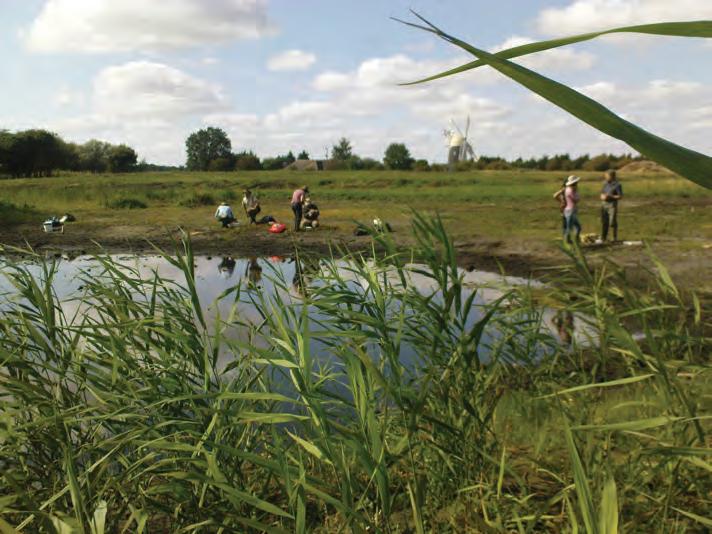






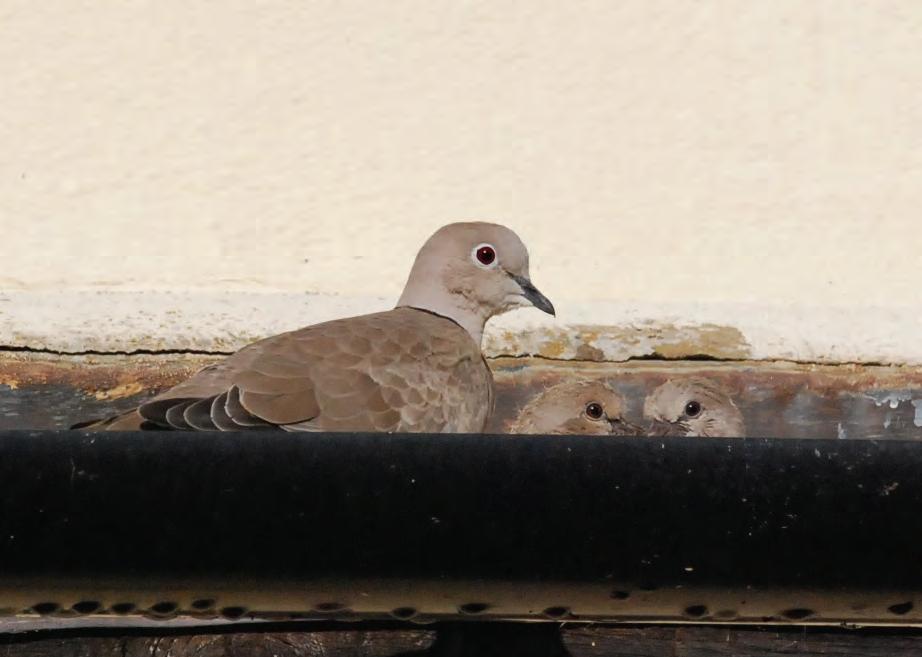
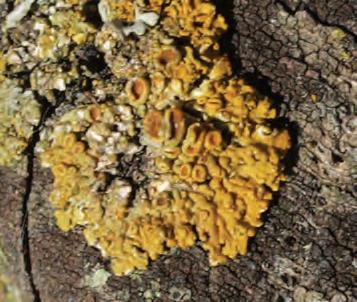



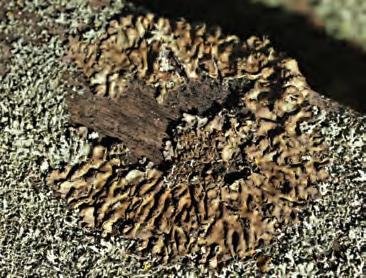
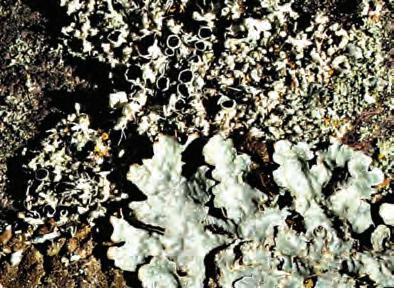
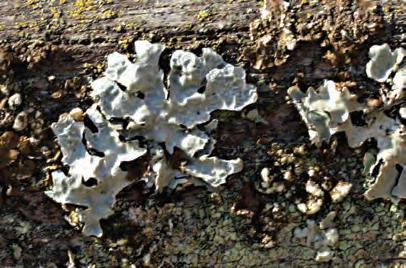

In the summer of 2007 a short article appeared in White Admiral No.67 about lichens on wood and how structures, such as fencing, took a long time to get to a state where lichens could colonise them before they decayed and were replaced. It was therefore exceedingly delightful, to discover a park bench in Aldeburgh, by the public library, which was well covered with lichens. On a subsequent visit, 18 species were recorded from the seat, and a note relating to the finds was written up in The Aldeburgh Gazette No.452 (September 2009).
The town council was contacted in case the seat might be cleaned, though in fact it was found to belong to Suffolk Coastal District Council, who when contacted said that they would leave it as it was. During a subsequent telephone call, it was discovered that the Council’s policy was to sweep round any seat, but not to clean it, so hopefully it will stay like it is for years to come.
Lichen species on the woodwork (* illustrated, Figs. 2 – 7).
Amandinea punctata
Candelariella vitellina
Flavoparmelia soredians*
Lecanora chlarotera
L. conizaeoides
L. expallens
Melanelixia subaurifera*
Micarea denigrata
Parmelia sulcata*
† c.fr. is Latin for con fructu, meaning with fruits. † cf. means comparable with.
Phaeophyscia orbicularis
Physcia adscendens
P. caesia
P. tenella c.fr.* †
Physconia grisea*
Xanthoria candelaria*
X. parietina
X. ucranica
X. cf. polycarpa* †
The bench, made of teak, which is a very hard and durable material has obviously been at its present position for a long time bearing in mind the need for weathering prior to colonisation and also evidenced by the fact that lichens are very slow growing, with increases in radius of about 0.5 to 1.5 mm per year. Thus for the thallus of Physconia grisea, (Fig. 4), which was approximately 4cm diameter, this would mean about 20 years growth and 10 years weathering time giving a total of 30 years. It will be very interesting to find out when in fact the bench was placed on the green.
The majority of the lichens, as can be seen in Fig. 1, are located on the seat, arms and top rail of the back. The slats forming the back of the seat, together with the legs and the reverse side are covered with Lecanora expallens, a pale green powdery crustose lichen, and also algae, which in places was parasitised by a fungus, (cf. Athelia arachnoidea), causing a bleached necrotic area.
Most of the lichens seen on the seat appeared to be present as one thallus only. The most common was the foliose species, Physcia tenella, which was colouring the seat grey and Xanthoria species, which, though orange, were much less evident.
These are indicators of the Xanthorion community, which is present in urban environments where there are higher levels of nitrogen (from car exhausts , and dogs, which foul bases of trees and lamp posts) and which sometimes turns roadside trees orange.
Some of the species present, such as Lecanora conizaeoides and Micarea denigrata are common constituents of this habitat, but others like Flavoparmelia soredians, Lecanora chlarotera, Melanelixia subaurifera and Parmelia sulcata are usually found on tree branches, so it was interesting to see them in this situation where they had probably developed from propagules of the lichens on the sycamore trees (Acer pseudoplatanus) trees close by. Flavoparmelia soredians, was immature and without soralia (powdery patches on the thallus), but its identity was confirmed by chemical tests.
Amandinea punctata and Phaeophyscia orbicularis are at home in a wide range of habitats, including trees, rocks, wood etc, so it was not surprising to see them on the seat. However, Candelarierlla vitellina and Physcia caesia prefer rocks, acidic for the former or basic for the latter. It is probable that the pH of the wood is neutral thus accommodating all the different species found.
One interesting lichen found on the seat was Xanthoria cf. Polycarpa Fig. 2. It is morphologically similar to X. polycarpa, but unlike that species, is widely spreading, with relatively few apothecia (fruits). It is thought to be a distinct, but unidentified taxon. It usually occurs on trees and is not uncommon, having been found several times in Suffolk. It also occurs in Scotland.
The photographs were taken with a digital SLR camera with an adjustable, live view monitor and fitted with a 150 mm macro lens. In addition to the usual problems of macro photography, the contrast between the light grey thallus of some species and darker surrounding lichens made finding a compromise exposure difficult and each subject was photographed with a one third or two thirds stop bracketing from which the final selection was made. Though depth of field was not a particular problem, manual focussing was used to ensure that diagnostic features such as apothecia were in sharpest focus.
A tripod was essential. Some of the lichens were in awkward places and a Benbo Traveller was used. This can be adjusted to all sorts of configurations, which together with the live view monitor greatly eased the task of framing the subject
The editor is very grateful to Mabel Kirby for proof-reading White Admiral over a number of years. She has had to withdraw her services for eyesight reasons. Her diligence, strict adherence to the Harvard referencing system and eagle-eyed attention to grammatical correctness have enabled members to enjoy error-free newsletters.
We left the story of James Paget’s early life at the point where the manuscript of the book on the natural history of the Yarmouth area which he had co-authored with his older brother Charles was with the printer in Yarmouth and he was now travelling by coach to London to embark on a medical career at St Bartholomew’s Hospital.
Publication of the Sketch of the natural history of Yarmouth and its neighbourhood
Upon arrival in London, the twenty year-old disembarked from the coach and was met by his older brother George, a doctor at Cambridge. It was George who had paid James’ entrance fees to St Barts because their impoverished father could not afford to. James entered St Barts on the third or fourth of October, 1834 and his life changed forever. Work at the hospital was hectic and because of his family connections, affable personality, eloquence and intelligence he became a much in demand guest at dinners and social gatherings. Later that month James and Charles’ book was finally printed. We are not sure of the size of the print run although we do know that four years later in 1838 there were 37 copies left unsold, 10 in Yarmouth and 27 in London. In a letter to his brother Alfred, James writes of his visit to their chosen publishers:
I went this morning to the places [Charles] mentioned. I could not help feeling rather queer, after having looked at about thirty booksellers’ and publishers’ names in Paternoster Row, where no other trade can live, & then going into half-adozen different counting-houses before I could find the right one, and being stared at by about 20 clerks and shopmen – discovering myself in the presence of one of the celebrated firm of Messrs. Longman, Rees, Orme and Brown, with a book of my own in my hand. I saw the last of these gentlemen, he showed a good deal of business civility, and said they had no objection to take 25 copies in the usual way, and try to sell them. Of course you are aware that they do not buy them.
The book was sold for half-a-crown which although cheap for that time might result in more copies being sold thereby generating more money for the family.
I have been unable to discover with certainty how the printed pages of text were covered. Before around 1830, books were generally published in paper “wrappers” or in “boards” (cardboard covered in paper) so that their wealthy purchasers could have them bound according to their own taste. Publishers’ cloth bindings were most commonly, from my own observations, in various shades of brown, and became usual from about 1830 although some important books were still being published in paper-covered parts until the 20th century. In 1834 when this book appeared it is almost certain that books were being published in both the new and old formats. I have been told, however, that a copy of the book which fetched over £400 in an auction in Norfolk in 2007 was bound in what was probably the original brown cloth (David Wilson, pers. comm.).
As was the custom, the brothers sent or personally gave copies of their book to wellknown naturalists. This brief letter by James accompanies a copy of the book sent to the botanist Dr. Hooker who was at that time widely regarded as the greatest English botanist and knew the study area well as he was of Norfolk origin:
My dear Sir,
Will you do my brother and myself the favour to accept the accompanying sketch, our maiden attempt as authors, and to treat with leniency the numerous defects which one so well acquainted with the subjects and localities it treats of as yourself must immediately discover.
By promoting their work in this way the brothers would have hoped that it would have a similar effect as a present-day, favourable review viz. the purchase of copies of the book; it also publicised the scientific credentials of the authors. This last for James would have been a very important first step towards recognition by the scientific community of which he aspired to become a respected member. Charles was engaged in trying to turn around the ailing Paget shipping and brewery businesses; self-promotion would not have been high, if at all, on his list of priorities. There is little doubt in my mind that, had it not been for James, the Sketch would not be in existence. Charles suffered from ill-health throughout his short life: he died in 1844 aged just 31 or thereabouts, and appears to have lacked the drive, initiative and self-confidence of his brother. I see him very much in the role of a highly competent, specialist contributor to what is essentially his younger brother’s book.
The Sketch of the Natural History of Yarmouth and its neighbourhood is a slim 8vo (147 x 228 mm) volume consisting of a 32-page Introduction written by James Paget and an 88-page Catalogue recording the animals and plants of the area. It will be remembered that Charles was responsible for the entomological part of it, James for all the rest. James tells us that he considered the enumeration of the species nearly complete and that he had used not merely his own collections, but those of all the local naturalists with whom he came into contact.
The Introduction details the climate, geology and habitats of the area and discusses each of the six taxa catalogued. It is written in unambiguous, precise prose and there are indications even at this early age, of James’ powers of careful observation. The following passage talking about the grasses of the beach gives a flavour of his writing style:
[On] the beach and the hills of drifted sand, which form the marrams, but few plants indeed could be expected to flourish, owing to the great want of water, which in the heaviest rains is almost immediately filtered through, before it has remained sufficient time to be absorbed by their roots. They consist almost entirely of the marram and some grasses, which require but little moisture, and of others whose long roots penetrate to a sufficient depth below the sand to enable them to reach any which may exist. But in few parts of the vegetable kingdom are more interesting cases of the beautiful adaptation of the different parts of creation to be found than here. Were it not for the simple uninteresting-looking plant, the marram-grass just mentioned, it is probable that all the country along the coast must long since have
been inundated or buried; its long creeping roots, extending in many instances for twelve or fourteen feet in length, at a distance of two or three inches below the surface, and crossing and matting with each other in every direction, effectually bind down the sand blown up from the beach; while the short strong foliage prevents its being blown over the land in the neighbourhood, which is thus maintained capable of high cultivation.
The Catalogue lists 766 animals (all five vertebrate classes and the insects), 729 flowering plants and 456 non-flowering plants. Its value lies in the fact that we know the brothers possessed all the important scientific works required for the correct identification of the species listed and that they submitted voucher specimens to experts for verification or exchange. We can therefore accept the majority of the species listed as being correctly identified according to the scientific knowledge of that time. We know from the Introduction that Charles had many insect specimens of whose identity he was uncertain; none of these were included although some queried names appear in his list – presumably those species which he was fairly confident were correctly named. However, careful readers of White Admiral will realise that the record of the beetle Panagaeus Crux-Major (sic) must surely be referred to Panagaeus bipustulatus F.
Plate 1, p.27 is illustrative of the Catalogue’s format, in this case the start of the insect section which begins with a list of 408 beetles found in the neighbourhood. Where named localities are given, the Suffolk and Norfolk records are easily distinguished. Of particular significance on this page are the records of the very hygrophilous Carabus clathratus a large, distinctive beetle which occurs in swamps, bogs and saline coastal marshes where it often hunts underwater. It was first found in Britain at Halvergate Marshes, Norfolk in 1809 where it occurred over the next few years; putative records from the Burgh marshes and from Belton Bog would appear, therefore, to be not unexpected. Records from 1809-1834 are the only ones (excluding obvious importations) of this large, characteristic beetle which lie well outside its subsequently established range viz. north-east Scotland and throughout Ireland. The beetle occurs in most of Europe except western and southern parts. Insect recording in the Pagets’ time was still in its infancy and it is impossible to verify these early records because specimens from this era are often without data, but there are two possible lines of speculation upon these occurrences. The most obvious is that these were isolated, long-established populations of clathratus which became extinct after these captures were recorded. The second is that there might at this time have been short-lived populations in this area perhaps as a result of relatively recent migration or transportation to the port from the continent - certain populations have long-winged individuals which can fly. Many examples of Calosoma sycophantathe next beetle on the list - were also turning up on this area of coast in this time period but not afterwards. These had all arrived from the continent but needed to reach woodland if they were to have any chance of establishing themselves; they didn’t. Immigrant clathratus, however, would probably have found themselves immediately at home in these coastal marshes. Much of James’ plant collection is incorporated in the main herbarium at Norwich Castle Museum but Charles’ insect
collection appears no longer extant. It may have been disposed of when the Pagets left their fine house on the Quay. We know that the contents of the house which included many fine art objects especially paintings were auctioned separately in 1848. At that time insect and other specimen cabinets were beautiful pieces of furniture crafted in order that they would fit in unobtrusively with the rest of a wealthy person’s sumptuous furniture. Only when the doors were opened and the drawers pulled out would a cabinet’s purpose be revealed.
Late in life, whilst writing his memoir, James looked back to the time of the Sketch and reflecting upon it he wrote:
I am amused in thinking that of the mere knowledge gained in the study - the knowledge of the appearances and names and botanical arrangement of plantsnone had in my after-life any measure of what is called practical utility. The knowledge was useless: the discipline of acquiring it was beyond all price.
These pages are not the place to detail the life of James Paget after 1834 but it was just such discipline coupled with a gift for original and often philosophical thinking allied to a tireless capacity for demanding work, which was to characterise James Paget’s brilliant career at St Barts as a surgeon and pathologist and lead to him becoming, together with the German Rudolf Virchow, one of the founders of scientific medical pathology. He moved in the highest echelons of intellectual social circles and, in this Darwin’s anniversary year, it is worth noting in conclusion, that he and Darwin became good friends, corresponding regularly on medical and other scientific matters of mutual interest.
Anyone who has found this account of the first twenty years of James Paget’s life interesting will not find his later life any less so. Although he understandably receives true acknowledgement of his achievements by being included in the Dictionary of National Biography, his relatively brief entry there cannot capture the true essence of this extraordinary man nor can the many sites on the web which adequately describe his life and achievements. Until a couple of years ago, my knowledge of the Pagets was largely confined to the contents of the Sketch and its importance (for me), as the first publication containing a local list of Suffolk beetles. It was then that I saw the following advertised on a website and purchased it: Paget, Sir James (1901). Memoirs and Letters of Sir James Paget - edited by Stephen Paget, one of his sons. Longmans, Green and Co. London.
Copies are readily available and inexpensive - I paid £15 for mine. The greater part of its almost 440 pages deals with James Paget’s life post-1834 so if I have whetted anyone’s appetite I can assure them that they will not merely be re-visiting the events described and interpreted here since these feature in only the first forty pages. I recommend the book without reservation: it is a fascinating, insightful and sensitive account of a life well-spent.
David Ridley Nash, 3 Church Lane, Brantham CO11 1PU
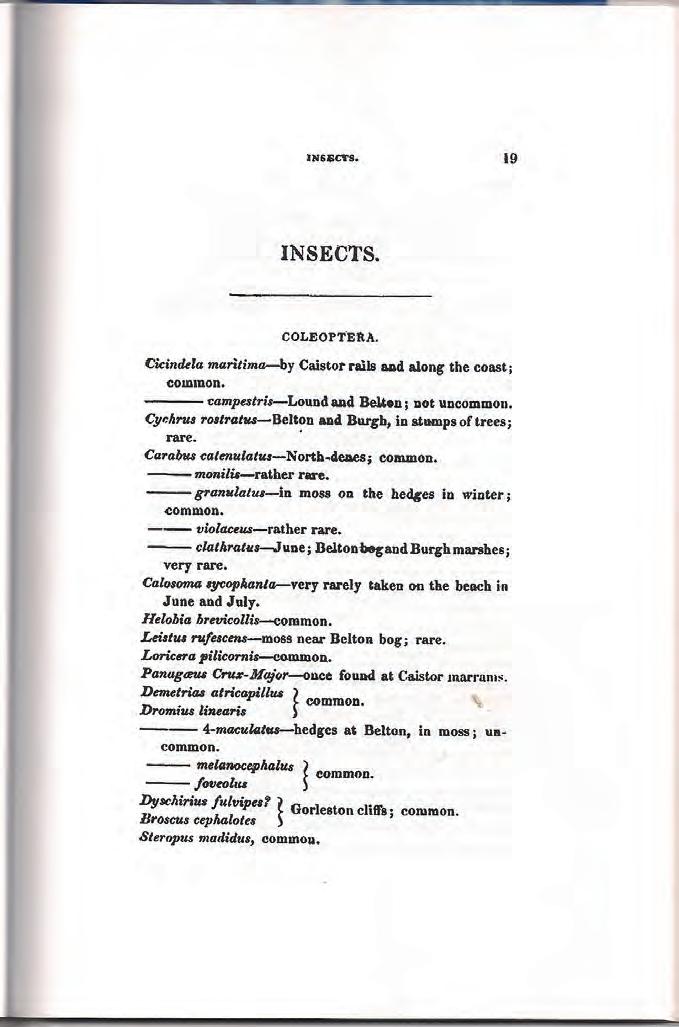
The specific name belladonna means ‘beautiful woman’, reflecting the fact that the shiny black fruits of this plant were once used by Italian women to enhance their attractiveness. They dropped extracts of the juice into their eyes, causing the pupils to dilate. The fruits contain several powerful alkaloids including atropine (hence the generic name) that inhibit the action of parasympathetic nerves. Atropine is still in use by ophthalmologists, who often need to dilate the pupils in order to have a clear view of the retina behind. They also use it therapeutically in cases of inflammation affecting the internal structures of the eye. In such cases dilation can help prevent permanent damage to the eye. I myself was prescribed atropine eyedrops in the 1970s. As well as dilating the pupil, the drug causes blurred vision, so I was glad that the inflammation I suffered was in one eye only and I was still able to read with the untreated eyed.
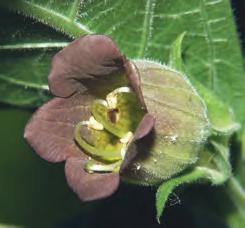
The alkaloids in deadly nightshade also account for its ‘spasmolytic’ action. Extracts of the plant can be given internally in very low doses, to relieve painful spasm affecting internal organs such as the gut and the ureters. I must emphasise here that the plant is toxic in all but the smallest doses and should on no account be tried as a home remedy!
Side effects include a dry mouth and racing heart. Higher doses can cause hallucinations, coma and death.
Herbalists retain their right to prescribe deadly nightshade, along with several other potent herbal remedies, under legislation passed in the early 1970s. However, this legislation is flawed because, despite negotiating over many years with successive governments, herbalists have yet to gain statutory regulation. Thus there is no legal definition of a herbalist. If this situation remains unchanged, trained herbalists could lose their access to many valued remedies when new European medicines legislation comes into force in 2011.
Deadly nightshade is not common in Suffolk, perhaps because it favours chalky soils. However Mabey describes a pale-flowered variety that occurs on a number of sites in Felixstowe. Francis Simpson is said to have removed the berries from these plants, lest they be uprooted in the name of ‘Health and Safety’.
References
Bartram, T. (1995). Bartram’s Encyclopaedia of Herbal Medicine. Robinsons, London.
European Herbal and Traditional Medicine Practitioners Association http:// www.ehpa.eu/ Mabey, R. (1996). Flora Britannica. Sinclair-Stevenson.
Caroline WheelerIslands are exotic, the smaller they get the less accessible they become. But above all they are fascinating because they have their own unique flora and fauna. Of course, that is as long as they are given a chance, occasionally even a helping hand but definitely not if there are destructive forces at work. This is the story of an island pitilessly mown down at an important time…
Every year for a few years now we have looked forward to the beginning of July. This is when this ‘island’ at the Norwich Road junction on the A14 blossoms with hundreds of pyramidal orchids in amongst the grasses and other wildflowers. Although traffic roars up and down on the A14 above and around the island below, this land-locked refuge is a place of safety and protection, a temple for the diverse wildlife, a peaceful haven. As a result it is an undisturbed piece of pristine countryside, a mini ‘nature reserve’. It is not unusual to see pink waves of orchids in the summer as you go round this ‘magical’ roundabout.
But alas, not this year. In early July, cheered by seeing the pink spikes on the grass verge of the approach road, we eagerly descended towards the traffic island. But we were in for a dreadful shock. It looked as though someone had come along in a tractor-mower and mowed it all down. How could anyone have done this? The island’s sacrosanct status had been ravaged. With one fell swoop this beautiful circular band of meadow had been destroyed. As if mowing all the wildflowers down was not bad enough, what had also gone were the livelihoods, the associations, an ecosystem. Gently we drove around the large roundabout, noticing in disbelief a full 5-metre strip had been cut down all around the perimeter of the island, in some places, as far back as was possible. The saving grace, thankfully, was the ‘inaccessible’ scrub area in the middle which could not be touched. We went around once again and this time we did spy a few pink spikes here and there just beyond the mown-line. So all was not lost. Fortuitously, some had survived the onslaught. The dilemma is when something like this happens there is very little one can do since it is not immediately reversible.
My main purpose that afternoon was to take photographs of the orchids, so we parked further down the Needham Market road and walked back. Gingerly, when all traffic was clear, we walked across onto the island. One starts to feel sort of unique and special – when did you last see someone on a roundabout, camera in hand, kneeling down nature-watching? I went from one spike to another admiring the different shades and sizes of the pyramids. The sun had come out now and flowers glistened in the light. As I homed on to this one lovely specimen, I suddenly detected a movement and was enchanted to see bleached legs advancing sideways out of the middle of the flowering spike. I watched in excitement and disbelief as the rest of this beast which looked like a tiny sun-bleached crab one often sees stranded on the seashore, squeezed through the small dainty flowers and on to the surface of the pyramid. However, this creature was neither dead nor a crab. It was a female (with a body length of around 10 mm; males are very much smaller) of the crab spider Misumena vatia, crystalline white and with the first two pairs of legs relatively long.
Even with all the care I took, I must have inadvertently ‘shaken’ the orchid and the spider lying in wait inside the inflorescence hidden until such time as an unwary visitor was to chance upon the flower. I thought I would look under another spike nearby and as I did so I noticed that there was a dense network of spurs and stalks and if there was a Misumena in amongst them it would be quite inconspicuous and would have no worries of being detected by predatory intruders from below! Yet it was in an ideal hiding place, a place of ambush, from which it could pounce onto an unsuspecting invertebrate visitor tempted by the foxy smell of the flowers of Anacamptis pyramidalis. A very neat arrangement, wouldn’t you say?
Suddenly a large truck went by bringing us back to reality. Not only the pyramidal orchids but all the Misumena had vanished with them. A feeling of sadness came over me. Just then, Misumena now facing the sky, displayed a courting attitude, front legs raised. ‘You can count your blessings, you are the lucky one’, I murmured.
My enquiry started with a phone call to the Mid-Suffolk District Council. Someone promised to find out for me. And what was really great was that I didn’t have long to wait. This person from the Highways Agency of Suffolk County Council rang me to explain. He told me they were just as shocked as we were to find out what had happened – that was a great relief! On further investigation, they had finally identified a householder not far from the roundabout who was responsible. However, on approaching him, they were told that a gardener they had hired to control their verges along the road had taken it upon himself, thinking he was doing everybody a favour, to carry out the ‘sad and destructive’ deed. Now everybody was sorry and hopefully it won’t happen again.
But there is a lesson to be learnt in this sorry tale. It falls on us all to try and make sure, by being vigilant, that these kinds of things don’t happen. I am personally eager to see what happens at junction 51 next year. Nature has a way of fighting back.
Rasik Bhadresa
Nominations of candidates for SNS Council are required by January 31st 2010.
Details on p.36
In White Admiral 73, on p.20, the photographs Figs. 1 & 2 should have been attributed to Niall Benvie. We are sorry about this omission and offer our apologies to Niall.
















Portable, outdoor, digital, recording cameras can be triggered to take a photograph of anything that moves in front of them. They are therefore very useful for tracking and monitoring the behaviour of animals during the 24 hours of day and night. During the day they produce both video and still pictures in colour and by night the pictures are formed by infra red light.
I use several of these cameras to monitor the behaviour of badgers: their distribution, their emergent and return times to their setts, their cleaning habits and their aggressive displays. It was while examining the results of one particular camera that I found that instead of recording a badger it had photographed a family of foxes. (See photograph above). The vixen had used the entrance to a badger sett in which to have her family, while a badger still used the same entrance!
Later the same camera revealed another mystery photograph. (See photograph below).




The photograph was taken at 9.51pm on the 23 June 2009 by infra red light.
A fox, seen in the picture, triggered the camera and a flying object was recorded as a white line (estimated at 10 metres long) with periodic white blobs on it. The camera shutter was open for 1/10th of a second, so if the white blobs were caused by wing beats, the rate would work out at 100 beats per second - too fast for a bird.
Other possibilities (if we reject little green men and flying foxes) are flying insects or bats but I still favour a bird with the white periodic blobs being caused by something other than wing beats. There is a tawny owl in the wood, which often comes to the camera, stands in front of it and takes it own photograph. They are not very good photographs but owls are not renowned for their photography. I think it is attracted by the red glow of the infra red light on the camera. Perhaps the wise old owl knows something about the mystery…
Any suggestions as to the cause of this recorded flying object would be received with the utmost enthusiasm.
Russell EdwardsThe British Trust for Ornithology (BTO) once again had a fantastic response to their House Martin survey. Observers reported over 2000 House Martin nests across Britain and Ireland. Eire boasted the highest number of nests this year, whilst southern England reported the lowest. Successful fledging of two or even three broods of young was recorded. Supporting the latter was a report of a brood of young in the Midlands that left the nest on October the 8th. Pairs will often attempt a late brood but it is always a gamble. In a mild autumn this can pay off and the extra brood will almost certainly fledge in time to make the long journey to Africa.
The House Martin survey 2009 newsletter contains some of the stories that the BTO received and answers some of the more frequent questions that were posed. To read these and see how our House Martins have fared this year, visit www.bto.org and click on the link to the House Martin Survey 2009. If you wish to find out more and keep up with the work of the BTO, such as the Garden Bird Survey, you can do so by subscribing to the free BTO e-newsletter at http://www.bto.org/news/ newsletter.htm. If you had House Martins nesting under your eaves in 2009, Paul Stancliffe would be pleased to hear from you at: paul.stancliffe@bto.org
Acknowledgement: most of this article has been reproduced almost verbatim, with permission, from an e-mail sent by Paul Stancliffe (BTO) to my wife, Ann, who took part in the survey.
Footnote: The House Martins in residence at our address in Bentley have occupied two artificial nests under the eaves for the past five years.
Colin HawesOn June the 8th this year, Niall Benvie arrived at our house in Bentley to take photographs of stag beetles and their larvae. He had not seen stag beetles before and was somewhat surprised at their size.
Soon, our small back garden lawn was covered with the equipment that a professional photographer uses. Males, females and larval pabulum (a small tree stump, riddled with larval tunnels) were duly photographed. Then it was time for the larvae to play a star role. A small heap of woody compost containing two large larvae was carefully tipped on to the ground and one larva selected for its moment of fame. But immediately on turning my back to place the larva in a suitable position, a male blackbird that, unknown to us had hidden itself in an adjacent shrub, shot out, grabbed the remaining larva and promptly ate it. We stood there in amazement, but had to laugh at such audacious opportunism. To cap it all, the cheeky bird even had the nerve to come back and look for more.
Colin Hawes
(Niall Benvie is a professional natural history photographer based in Scotland. His work can be seen on the web at: Nature photography with Niall Benvie or Niall Benvie. Images from the Edge.)
Sadistic Robin
Sunday morning the eleventh of October: the quiet tranquillity was abruptly terminated by two flying robins chasing one another across the lawn and then bang. The pursued robin had crashed into the window and dropped to the ground, head down and motionless. I thought for a moment it was only stunned and would recover and fly off but after a few minutes the pursuing robin returned and proceeded to attack the now dead robin. It was a vicious attack concentrating on its face and eyes, dragging the body around and turning it over. The robin would then fly into the hedge to rest for a few minutes before continuing its attack again. This continued on and off for the rest of the morning until I took the body away and disposed of it.
I can only presume that the dead robin died within the territory of the resident robin and the latter set out to remove the victim whether it was dead or alive.
Today looking across the lawn I noted a pair of robins happily flitting amongst the undergrowth. It seems a bit early for pairing off but there they were.
Russell EdwardsOn 10th September I was walking at Colton Creek near Chelmondiston when I found the corpse of a recently deceased Redshank. A Sexton Beetle had already found the body, even though it lay on intertidal saltmarsh.
The bird had a leg ring so I duly noted its number and sent the details off to the British Trust for Ornithology. I have just received back the bird’s details, which are quite fascinating. It was rung as a one year old by “Newton and Wright” on 11th September 1999, a day off 10 years before it died. I did not know that these birds could live so long. It was rung in Levington Lagoon barely 3 Km from its last resting place. Did this bird migrate thousands of miles every year, to return to the very same estuary every winter for all its 11 years? The ringing summary “Time since ringing: 3652 days Distance 3 Km” does not do justice to this amazing bird and the life it must have led.
This story shows the importance of looking for rings on dead birds and reporting the find. Yes, it is a bit macabre, but it is the reason why bands of dedicated ringers spend endless hours catching and tagging birds, with the vast majority of rings never being recovered.
Adrian Knowles
Jessups Cottage, London Road, Capel St Mary
P.S. The BTO reckons that four to five years is a typical life expectancy for Redshank, but the British record is 20 years.

The Mammals of Suffolk by Simone Bullion £23.50 incl. p & p
Order by phone 01473 433547
Contributions to White Admiral Deadlines for copy are 1st February (spring edition), 1st June (summer edition) and 1st October (autumn edition).
The opinions expressed in White Admiral are not necessarily those of the Editor or of the Suffolk Naturalists’ Society.
Nominations of candidates for election to Council are required by 31st January 2010 in accordance with clause 3.4 of the constitution:-
3.4 The Officers of the Society and elected members of Council shall be elected at an Annual General Meeting. Nominees must be proposed by a fully paid up member of the Society and duly seconded by another fully paid up member. The nomination shall be given to the Honorary Secretary in writing before January 31st.
Please write to:-
The Honorary Secretary
Suffolk Naturalists’ Society
c/o The Ipswich Museum
High Street
Ipswich
Members who are carrying out an investigation or study of an aspect of natural history are encouraged to apply for an SNS bursary. Bursaries are intended to provide financial help with the project.
Details of the application procedure can be seen on the inside of the back cover of this newsletter. Bursary funds were not fully taken up in 2009.
Howard Mendel resigned as Chairman and Treasurer with immediate effect from 9th November 2009.
Until the AGM in April 2010 the officers of the society are as follows:-
Acting Chairman - Adrian Knowles
Acting Treasurer - Joan Hardingham
Acting Hon. Sec. - Colin Hawes
An appreciation of Howard Mendel’s long service will appear in the next edition of the newsletter.
The Suffolk Naturalists’ Society offers five bursaries, of up to £100 each, annually.
Morley Bursary - usually awarded for studies involving insects (or other invertebrates) other than butterflies and moths.
Chipperfield Bursary - usually awarded for studies involving butterflies or moths.
Cranbrook Bursary - usually awarded for studies involving mammals or birds.
Rivis Bursary - usually awarded for studies into the County’s flora.
Simpson Bursary - in memory of Francis Simpson; this will be for a botanical study where possible.
Any member wishing to apply for a bursary should write, with details of their proposed project, to the Honorary Secretary. As applications are normally considered at the Council meeting in May of each year, proposals should be with the Hon. Sec. by 30th April.
Applications made at other times will be considered but, even if considered worthy of an award, may not be successful if all the bursaries for the current year have already been taken.
The following two conditions apply to the awards:
1. Projects should include a large element of original work and applications must include a breakdown of how the bursary will be spent.
2. A written account of the project is required within 12 months of receipt of a bursary. This should be in a form suitable for publication in one of the Society’s journals: Suffolk Natural History, Suffolk Birds or White Admiral.




FOUNDED IN 1929 by Claude Morley (1874 -1951), The Suffolk Naturalists’ Society pioneered the study and recording of the County’s flora, fauna and geology, to promote a wider interest in natural history.
Recording the natural history of Suffolk is still one of the Society’s primary objects, and members’ observations are fed to a network of specialist recorders for possible publication before being deposited in the Suffolk Biological Records Centre, which is based in Ipswich Museum.
Suffolk Natural History, a review of the County’s wildlife, and Suffolk Birds, the County bird report, are two high quality annual publications issued free to members. The Society also publishes a newsletter, White Admiral, and organises two members’ evenings a year plus a conference every two years .
Subscriptions: Individual members £15.00; Family membership £17.00; Corporate membership £17.00. Joint membership with the Suffolk Ornithologists’ Group: Individual members £26.00; Family membership £30.00.
As defined by the Constitution of this Society its objects shall be:
2.1 To study and record the fauna, flora and geology of the County
2.2 To publish a Transactions and Proceedings and a Bird Report. These shall be free to members except those whose annual subscriptions are in arrears
2.3 To liaise with other natural history societies and conservation bodies in the County
2.4 To promote interest in natural history and the activities of the Society
For more details about the Suffolk Naturalists’ Society contact: Hon. Secretary, Suffolk Naturalists’ Society, c/o Ipswich Museum, High Street, IPSWICH, IP1 3QH. Telephone 01473 433550
The Society’s website is at www.sns.org.uk